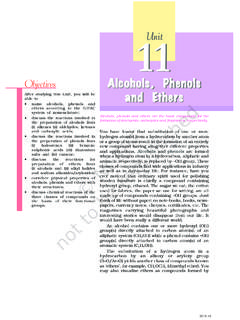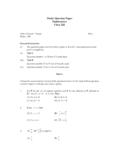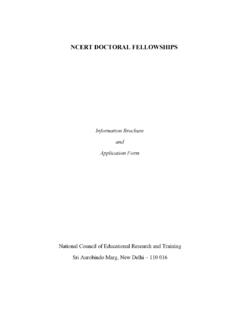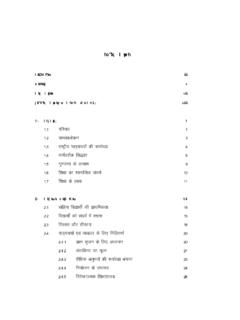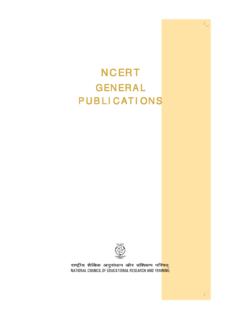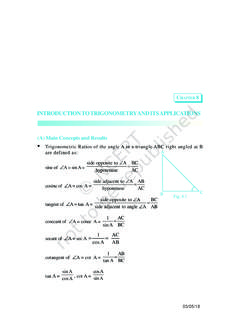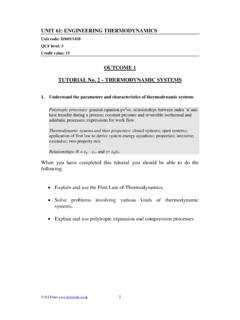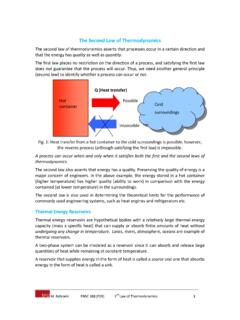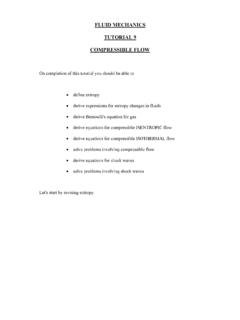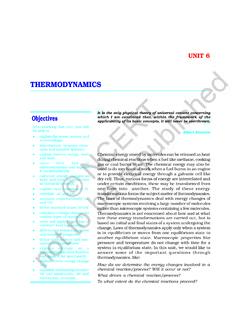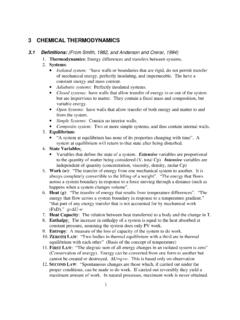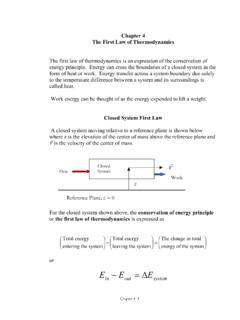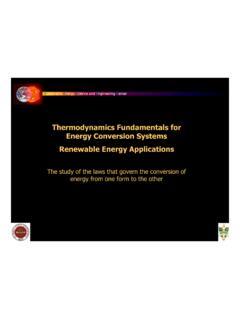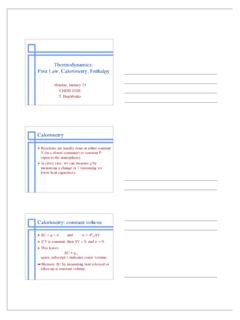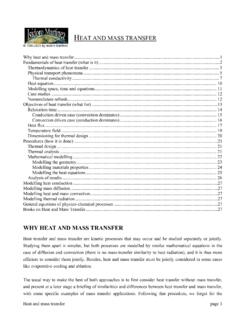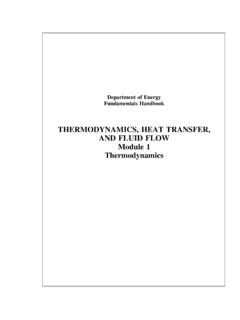Transcription of THERMODYNAMICS
1 CHAPTER INTRODUCTIONIn previous chapter we have studied thermal properties ofmatter. In this chapter we shall study laws that governthermal energy. We shall study the processes where work isconverted into heat and vice versa. In winter, when we rubour palms together, we feel warmer; here work done in rubbingproduces the heat . Conversely, in a steam engine, the heat of the steam is used to do useful work in moving the pistons,which in turn rotate the wheels of the physics, we need to define the notions of heat,temperature, work, etc. more carefully. Historically, it took along time to arrive at the proper concept of heat . Before themodern picture, heat was regarded as a fine invisible fluidfilling in the pores of a substance. On contact between a hotbody and a cold body, the fluid (called caloric) flowed fromthe colder to the hotter body! This is similar to what happenswhen a horizontal pipe connects two tanks containing waterup to different heights.
2 The flow continues until the levels ofwater in the two tanks are the same. Likewise, in the caloric picture of heat, heat flows until the caloric levels ( , thetemperatures) time, the picture of heat as a fluid was discarded infavour of the modern concept of heat as a form of energy. Animportant experiment in this connection was due to BenjaminThomson (also known as Count Rumford) in 1798. Heobserved that boring of a brass cannon generated a lot ofheat, indeed enough to boil water. More significantly, theamount of heat produced depended on the work done (by thehorses employed for turning the drill) but not on thesharpness of the drill. In the caloric picture, a sharper drillwould scoop out more heat fluid from the pores; but thiswas not observed. A most natural explanation of theobservations was that heat was a form of energy and theexperiment demonstrated conversion of energy from one formto another from work to law , internal energy law heat statevariables and equation and law and engineSummaryPoints to ponderExercises2020-21 PHYSICS304 THERMODYNAMICS is the branch of physics thatdeals with the concepts of heat and temperatureand the inter-conversion of heat and other formsof energy.
3 THERMODYNAMICS is a macroscopicscience. It deals with bulk systems and does notgo into the molecular constitution of matter. Infact, its concepts and laws were formulated in thenineteenth century before the molecular pictureof matter was firmly established. Thermodynamicdescription involves relatively few macroscopicvariables of the system, which are suggested bycommon sense and can be usually measureddirectly. A microscopic description of a gas, forexample, would involve specifying the co-ordinatesand velocities of the huge number of moleculesconstituting the gas. The description in kinetictheory of gases is not so detailed but it does involvemolecular distribution of description of a gas, on the otherhand, avoids the molecular description , the state of a gas in THERMODYNAMICS isspecified by macroscopic variables such aspressure, volume, temperature, mass andcomposition that are felt by our sense perceptionsand are measurable*.
4 The distinction between mechanics andthermodynamics is worth bearing in mind. Inmechanics, our interest is in the motion of particlesor bodies under the action of forces and is not concerned with themotion of the system as a whole. It is concernedwith the internal macroscopic state of the a bullet is fired from a gun, what changesis the mechanical state of the bullet (its kineticenergy, in particular), not its temperature. Whenthe bullet pierces a wood and stops, the kineticenergy of the bullet gets converted into heat,changing the temperature of the bullet and thesurrounding layers of wood. Temperature isrelated to the energy of the internal (disordered)motion of the bullet, not to the motion of the bulletas a THERMAL EQUILIBRIUME quilibrium in mechanics means that the netexternal force and torque on a system are term equilibrium in THERMODYNAMICS appearsin a different context : we say the state of a systemis an equilibrium state if the macroscopicvariables that characterise the system do notchange in time.
5 For example, a gas inside a closedrigid container, completely insulated from itssurroundings, with fixed values of pressure,volume, temperature, mass and composition thatdo not change with time, is in a state ofthermodynamic (a) Systems A and B (two gases) separatedby an adiabatic wall an insulating wallthat does not allow flow of heat. (b) Thesame systems A and B separated by adiathermic wall a conducting wall thatallows heat to flow from one to another. Inthis case, thermal equilibrium is attainedin due general, whether or not a system is in a stateof equilibrium depends on the surroundings andthe nature of the wall that separates the systemfrom the surroundings. Consider two gases A andB occupying two different containers. We knowexperimentally that pressure and volume of agiven mass of gas can be chosen to be its twoindependent variables.
6 Let the pressure andvolume of the gases be (PA, VA) and (PB, VB)respectively. Suppose first that the two systemsare put in proximity but are separated by an(a)(b)* THERMODYNAMICS may also involve other variables that are not so obvious to our senses entropy, enthalpy,etc., and they are all macroscopic variables. However, a thermodynamic state is specified by five statevariables viz., pressure, volume, temperature, internal energy and entropy. Entropy is a measure of disordernessin the system. Enthalpy is a measure of total heat content of the wall an insulating wall (can bemovable) that does not allow flow of energy (heat)from one to another. The systems are insulatedfrom the rest of the surroundings also by similaradiabatic walls. The situation is shownschematically in Fig. (a). In this case, it isfound that any possible pair of values (PA, VA) willbe in equilibrium with any possible pair of values(PB, VB).
7 Next, suppose that the adiabatic wall isreplaced by a diathermic wall a conducting wallthat allows energy flow (heat) from one to is then found that the macroscopic variables ofthe systems A and B change spontaneously untilboth the systems attain equilibrium states. Afterthat there is no change in their states. Thesituation is shown in Fig. (b). The pressureand volume variables of the two gases change to(PB , VB ) and (PA , VA ) such that the new statesof A and B are in equilibrium with each other*.There is no more energy flow from one to then say that the system A is in thermalequilibrium with the system characterises the situation of thermalequilibrium between two systems ? You can guessthe answer from your experience. In thermalequilibrium, the temperatures of the two systemsare equal. We shall see how does one arrive at theconcept of temperature in THERMODYNAMICS ?
8 TheZeroth law of THERMODYNAMICS provides the ZEROTH LAW OF THERMODYNAMICSI magine two systems A and B, separated by anadiabatic wall, while each is in contact with a thirdsystem C, via a conducting wall [Fig. (a)]. Thestates of the systems ( , their macroscopicvariables) will change until both A and B come tothermal equilibrium with C. After this is achieved,suppose that the adiabatic wall between A and Bis replaced by a conducting wall and C is insulatedfrom A and B by an adiabatic wall [ (b)]. Itis found that the states of A and B change nofurther they are found to be in thermalequilibrium with each other. This observationforms the basis of the Zeroth Law ofThermodynamics, which states that twosystems in thermal equilibrium with a thirdsystem separately are in thermal equilibriumwith each other . Fowler formulated thislaw in 1931 long after the first and second Lawsof THERMODYNAMICS were stated and so Zeroth Law clearly suggests that when twosystems A and B, are in thermal equilibrium,there must be a physical quantity that has thesame value for both.
9 This thermodynamicvariable whose value is equal for two systems inthermal equilibrium is called temperature (T).Thus, if A and B are separately in equilibriumwith C, TA = TC and TB = TC. This implies thatTA = TB the systems A and B are also inthermal have arrived at the concept of temperatureformally via the Zeroth Law. The next questionis :how to assign numerical values totemperatures of different bodies ? In other words,how do we construct a scale of temperature ?Thermometry deals with this basic question towhich we turn in the next (a) Systems A and B are separated by anadiabatic wall, while each is in contactwith a third system C via a conductingwall. (b) The adiabatic wall between Aand B is replaced by a conducting wall,while C is insulated from A and B by anadiabatic wall.*Both the variables need not change. It depends on the constraints.
10 For instance, if the gases are in containersof fixed volume, only the pressures of the gases would change to achieve thermal equilibrium.(a)(b) HEAT, INTERNAL ENERGY AND WORKThe Zeroth Law of THERMODYNAMICS led us tothe concept of temperature that agrees with ourcommonsense notion. Temperature is a markerof the hotness of a body. It determines thedirection of flow of heat when two bodies areplaced in thermal contact. Heat flows from thebody at a higher temperature to the one at lowertemperature. The flow stops when thetemperatures equalise; the two bodies are thenin thermal equilibrium. We saw in some detailhow to construct temperature scales to assigntemperatures to different bodies. We nowdescribe the concepts of heat and other relevantquantities like internal energy and concept of internal energy of a system isnot difficult to understand. We know that everybulk system consists of a large number ofmolecules.
